If you’re looking for a versatile and efficient kitchen tool. In that case, a food processor can be a great addition to your cooking arsenal. Among the many available options, KitchenAid food processors are a popular choice for home cooks and professional chefs. In this article, we’ll introduce you to KitchenAid food processors and show why they are worth considering.
Table of Contents
Discover the world of KitchenAid food processors.
KitchenAid food processors are popular for home cooks and professional chefs, thanks to their powerful motors, versatile blades, and user-friendly design. Whether chopping, slicing, grating, pureeing, or mixing ingredients, a KitchenAid food processor can help you do it with less effort and more precision. In this article, we’ll explore the features of KitchenAid food processors in more detail so that you can choose the suitable model for your needs.
One of the main advantages of KitchenAid food processors is their powerful and durable motors. Depending on the model, these appliances can have motor powers ranging from 250 to 720 watts, which means they can easily handle even tough and dense ingredients. In addition, KitchenAid food processors typically have multiple speed settings, allowing you to adjust the speed to suit the task at hand.
Benefits of using a KitchenAid food processor
So, what are the benefits of using a KitchenAid food processor? Here are some of the most compelling ones:
- Time-saving: With a KitchenAid food processor, you can significantly reduce your food preparation time, as you can process large quantities of ingredients in seconds.
- Consistency: A food processor can help you achieve consistent results every time, as it can chop, slice, and puree ingredients evenly.
- Versatility: KitchenAid food processors come with various blades and accessories, allowing you to perform multiple tasks with the same appliance.
- Convenience: Food processors are generally easy to use and clean and take up less space than multiple appliances.
- Creativity: With a food processor, you can experiment with different recipes and techniques and unleash your culinary creativity.
Types of KitchenAid food processors available
KitchenAid offers a range of food processors to suit different needs and preferences. Here are the different types of KitchenAid food processors available:
Mini food processor: The KitchenAid Mini Food Processor is a compact and lightweight option that is perfect for small kitchens or for those who don’t need a large-capacity food processor. It has a 3.5-cup bowl capacity and is ideal for chopping, pureeing, and grinding small quantities of food.
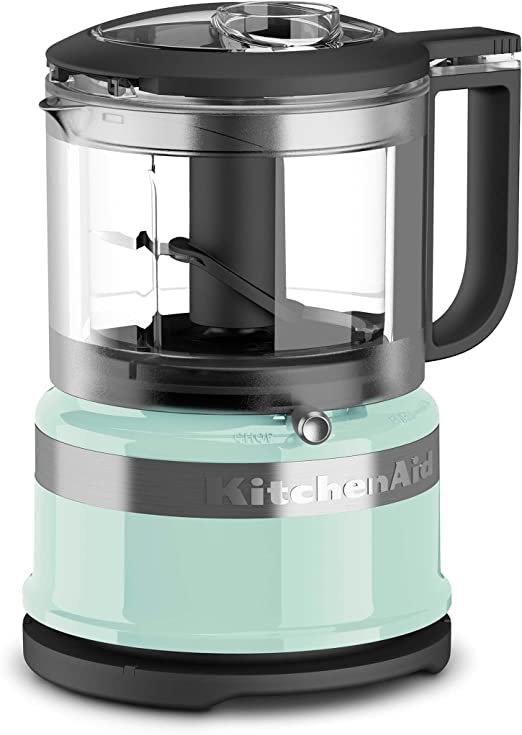
Kitchenaid food processor 7 cups: The KitchenAid 7-Cup Food Processor is a mid-sized option for everyday use. It has a 7-cup bowl capacity and has various blades and accessories for chopping, slicing, shredding, and pureeing. It also features a 2-in-1 feed tube that allows you to process different sizes of food without precutting them.
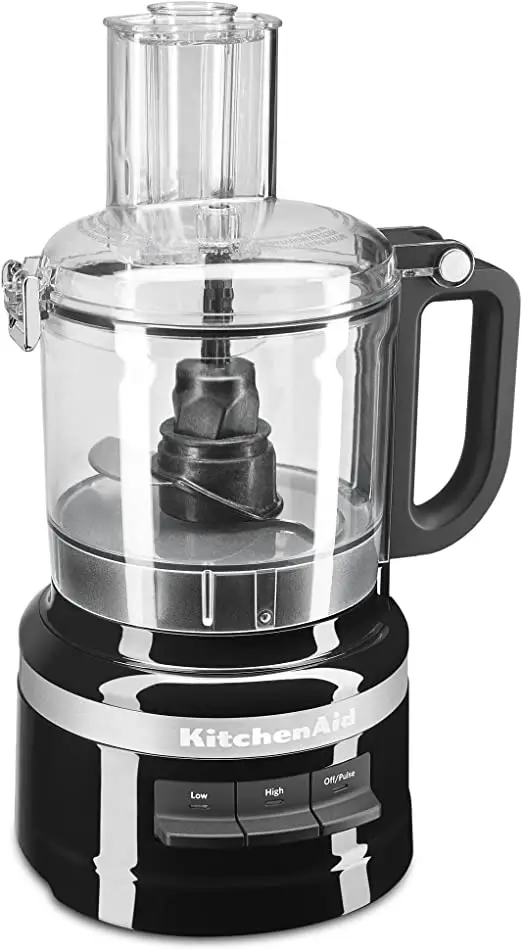
Kitchenaid food processor 9 cups: The KitchenAid 9-Cup Food Processor is a more practical option for families or those who like to entertain. It has a 9-cup bowl capacity and has various blades and accessories for chopping, slicing, shredding, and pureeing. It also features a 3-in-1 ultra-wide mouth feed tube that allows you to process large or small foods without precutting them.
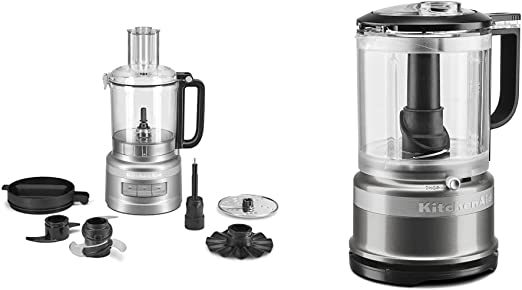
Kitchenaid food processor 11 cups: The KitchenAid 11-Cup Food Processor is a high-capacity option perfect for those who do a lot of food prep or who like to cook in large quantities. It has an 11-cup bowl capacity and has various blades and accessories for chopping, slicing, shredding, and pureeing. It also features a 3-in-1 ultra-wide mouth feed tube that allows you to process large or small foods without precutting them.
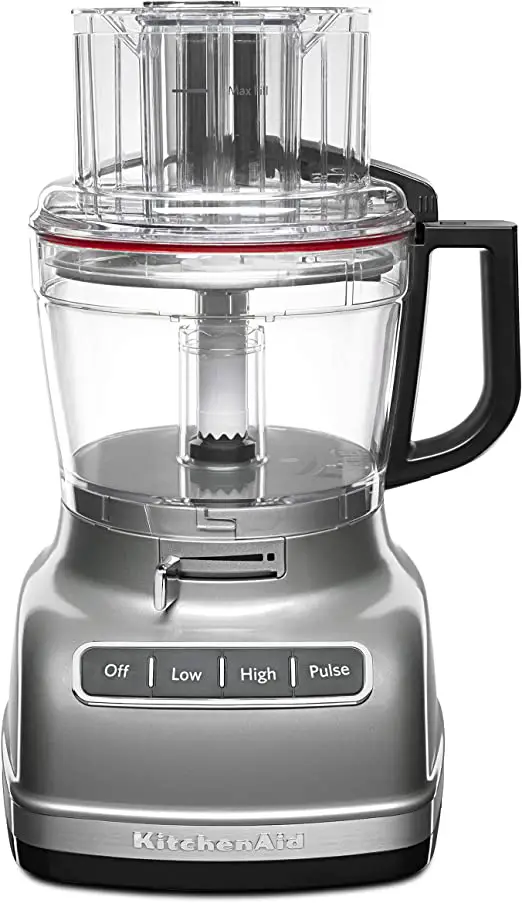
Food Processor Attachment: The KitchenAid Food Processor Attachment is an add-on accessory that allows you to turn your KitchenAid stand mixer into a food processor. It has various blades and accessories for chopping, slicing, shredding, and pureeing. It is an excellent option for those who already own a KitchenAid stand mixer and want to expand its capabilities without purchasing a separate appliance.
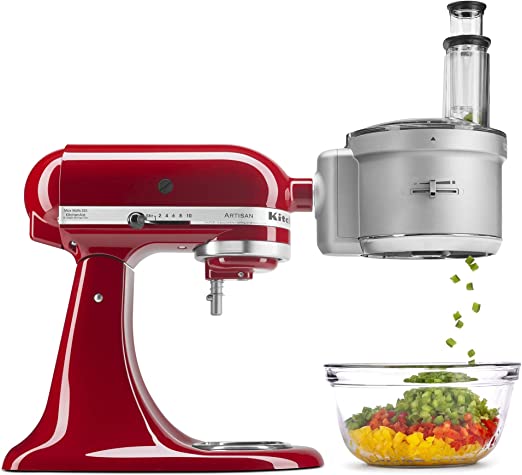
Commercial Food Processor: The KitchenAid Commercial Food Processor is a heavy-duty option designed for commercial kitchens or those needing to process large quantities of food regularly. It has a 16-cup bowl capacity and features a powerful motor that can easily handle tough ingredients. It also has various blades and accessories for chopping, slicing, shredding, and pureeing.
Features of KitchenAid Food Processors
Motor Power and Speed Settings
A food processor’s most essential features are its motor power and speed settings. KitchenAid food processors come with motors that range from 250 to 720 watts, depending on the model. A higher wattage motor generally means better performance and more durability, as it can easily handle tough and dense ingredients. In addition, KitchenAid food processors typically have multiple speed settings, allowing you to adjust the speed to suit the task at hand. Some models also have a pulse function, enabling you to chop ingredients in short bursts for more precise control.
Bowl Capacity and Size
Another important feature to consider when choosing a KitchenAid food processor is the bowl capacity and size. KitchenAid food processors come in different bowl sizes, ranging from 3 cups to 11 cups, depending on the model. A larger bowl capacity allows you to process bigger batches of ingredients, which can be helpful if you’re cooking for a crowd or meal prepping. However, a larger bowl also means a bigger and heavier appliance, which can be harder to store and handle. A smaller bowl, on the other hand, can be more compact and convenient for small tasks.
Blade Types and Accessories
KitchenAid food processors come with various blades and accessories, allowing you to perform multiple tasks with the same appliance. Here are some of the most common blade types and accessories you’ll find in KitchenAid food processors:
- S-shaped blade: This is the most versatile blade, as it can be used for chopping, pureeing, and mixing ingredients.
- Reversible shredding/slicing disc: This disc can be flipped over to switch between shredding and slicing vegetables, cheese, and other foods.
- Dough blade: This is designed to knead and mix bread, pizza, and pasta dough.
- Julienne disc: This disc creates thin strips of vegetables and fruits for salads and stir-fries.
- French fry disc: This disc cuts potatoes and other vegetables into thin, uniform sticks for homemade fries.
In addition to these blades, KitchenAid food processors may come with other accessories, such as a citrus juicer, a whisk, and a blade storage case. Some models even have interchangeable blade systems, allowing you to switch between blades and accessories easily.
Safety Features and Ease of Use
When using a food processor, safety should be a top priority. KitchenAid food processors have several safety features, such as a safety interlock system that prevents the machine from turning on unless the bowl and lid are properly locked. Some models also have a soft start feature, which gradually increases the speed of the motor to prevent ingredients from flying out of the bowl.
In addition to safety features, KitchenAid food processors are designed to be easy to use and clean. The bowls and blades are typically dishwasher safe, and the controls are intuitive and easy to understand. Some models even come with a wide-mouth feed tube, which allows you to process larger ingredients without precutting them.
Choosing the Right KitchenAid Food Processor
Understanding Your Food Processing Needs
The first step in choosing a KitchenAid food processor is to consider what you’ll use it for. Do you need a compact model for small tasks, such as chopping herbs and making dips? Or do you need a larger model for more complex tasks, such as kneading dough and shredding cheese? Please list the tasks you’ll perform most often and choose a model that can easily handle them.
Considering Your Budget and Available Space
Another important factor to consider is your budget and available space. KitchenAid food processors come in various prices, from under $50 for mini models to over $300 for high-end models. Consider how much you’re willing to spend, and choose a model that fits your budget without sacrificing the features you need. In addition, consider the size of the appliance and whether you have enough counter or storage space for it.
Comparing Different Models and Features
Once you have a good idea of your food processing needs and budget, it’s time to compare different models and features. Look for models with the needed features, such as a powerful motor, multiple speed settings, and versatile blades. Consider whether you want a large or small bowl capacity model and need additional accessories. Look for models that are easy to use and clean and have a good warranty.
Reading Reviews and Recommendations
Finally, before making a final decision, read reviews and recommendations from other users and experts. Check online reviews from sites like Amazon and Consumer Reports, and ask for recommendations from friends and family members who own a KitchenAid food processor; This can help you better understand the pros and cons of different models and make a more informed decision.
How to Use a KitchenAid Food Processor
KitchenAid food processors are easy to use and can save a lot of time in the kitchen. Here are some steps to follow to ensure that you get the most out of your food processor:
Setting Up and Assembling Your Food Processor
Before using your KitchenAid food processor, setting it up and assembling it correctly is essential. Start by choosing the appropriate blade or accessory for the task you’ll be performing. Ensure the bowl is clean and dry and that the blade or accessory is properly inserted into the center of the bowl. Place the lid on top of the bowl, and ensure it’s locked securely.
Preparing Ingredients and Foods for Processing
To ensure that your food processor works efficiently and effectively, preparing your ingredients and foods properly before processing is necessary; This may involve chopping larger ingredients into smaller pieces, removing any bones or seeds, or peeling fruits and vegetables. Follow the instructions in your recipe to ensure that your ingredients are prepared correctly before adding them to the food processor.
Using Different Blades and Accessories for Different Tasks
One of the key advantages of a KitchenAid food processor is the ability to use different blades and accessories for different tasks. For example, you might use the S-shaped blade to chop vegetables, the shredding blade to shred cheese, or the dough blade to knead bread dough. Refer to the instruction manual to determine which blade or accessory is best for your task, and ensure you insert it properly into the bowl.
Cleaning and Maintaining Your Food Processor
After using your KitchenAid food processor, it’s important to clean it properly to ensure it continues functioning effectively. Start by unplugging the machine and disassembling the bowl and blades. Wash the bowl and blades in warm, soapy water, and rinse them thoroughly. Some parts may be dishwasher safe, so check the instruction manual to see which parts can be washed in the dishwasher. Dry all parts thoroughly before reassembling the food processor.
Maintaining your KitchenAid food processor properly is important to ensure that it lasts a long time; This may involve regularly checking the blade’s sharpness, replacing any worn or damaged parts, and lubricating any moving parts. Refer to the instruction manual for specific maintenance instructions for your model.
Recipes and Ideas for Using a KitchenAid Food Processor
A KitchenAid food processor is a versatile kitchen appliance that can help you with various food preparation tasks. Here are some recipes and ideas for using your KitchenAid food processor:
Making Homemade Salsas, Sauces, and Dips
One of the easiest and most popular ways to use a KitchenAid food processor is to make homemade salsas, sauces, and dips. Chop your ingredients into smaller pieces, add them to the bowl, and pulse until the desired consistency is achieved. Some popular recipes include tomato salsa, guacamole, pesto, and hummus.
Chopping and Pureeing Vegetables for Soups and Stews
A KitchenAid food processor is also great for chopping and pureeing vegetables for soups and stews. Chop your vegetables into smaller pieces and add them to the bowl. Pulse until the desired consistency is achieved, and then add them to your soup or stew. You can also use your food processor to puree fruits and vegetables for baby food.
Grinding Meat and Making Homemade Burgers and Sausages
If you’re a fan of homemade burgers and sausages, a KitchenAid food processor can help you grind your meat. Cut your meat into smaller pieces and add them to the bowl. Pulse until the desired consistency is achieved, and then use the ground meat to make burgers, sausages, or meatballs.
Making Breadcrumbs, Nut Butter, and Flour
A KitchenAid food processor can also help you make breadcrumbs, nut butter, and flour. For breadcrumbs, pulse stale bread in the food processor until you achieve the desired consistency. For nut butter, add your nuts to the bowl and process until they reach a smooth and creamy consistency. For flour, add your grains or nuts to the bowl and process until they reach a fine flour-like consistency.
Whipping Cream and Making Homemade Mayonnaise
A KitchenAid food processor can also be used to whip cream and make homemade mayonnaise. For the whipped cream, add your cream and any sweeteners or flavorings to the bowl and process until the cream is whipped to your desired consistency. For mayonnaise, add your egg yolks, vinegar, and seasonings to the bowl and process until the mixture is smooth. While the machine is running, slowly add oil until the mixture emulsifies into mayonnaise.
FAQ
What is the Warranty on a KitchenAid Food Processor?
KitchenAid offers a one-year warranty on its food processors, covering material and workmanship defects. Some retailers may offer extended warranties or protection plans, so checking with them before purchasing is worth checking.
Can You Process Hot Foods in a KitchenAid Food Processor?
It is not recommended to process hot foods in a KitchenAid food processor. The heat can damage the plastic components of the food processor, and it can also be dangerous as hot liquids can splash out of the bowl. It is best to let hot foods cool down before processing them.
Is KitchenAid Food Processors Dishwasher Safe?
Most parts of a KitchenAid food processor are dishwasher safe, including the bowl, lid, blades, and other accessories. However, checking the user manual for specific instructions and avoiding placing certain parts in the dishwasher, such as the motor base, is recommended.
How Do You Replace Blades and Accessories on a KitchenAid Food Processor?
Replacing blades and accessories on a KitchenAid food processor is a straightforward process. First, ensure the food processor is unplugged, and the bowl is empty. Then, remove the old blade or accessory by twisting it counterclockwise and pulling it out. Please insert the new blade or accessory by aligning it with the drive shaft and rotating it clockwise until it clicks into place.
What are Some Common Problems with KitchenAid Food Processors, and How to Fix Them?
Some common problems with KitchenAid food processors include the motor not turning on, food not processing evenly, and blades getting stuck. To fix these issues:
1. Ensure the food processor is assembled correctly and plugged in.
2. Use the pulse function to avoid over-processing and overloading the bowl. If the blades get stuck, turn off the food processor and use a spatula or other tool to dislodge any food that may be stuck.
3. If the problem persists, consult the user manual or contact KitchenAid customer support for assistance.
Last thought
In conclusion, KitchenAid food processors are a versatile and essential tool for any home cook or professional chef. With their powerful motors, various blade types and accessories, and safety features, KitchenAid food processors can help you save time and effort in the kitchen.
Whether making salsas, soups, burgers, or even homemade nut butter, a KitchenAid food processor can make the process easier and more efficient. When choosing a KitchenAid food processor, consider your processing needs, budget, and available space to find the model that suits you best. With proper use and maintenance, a KitchenAid food processor can be a valuable addition to your kitchen for years.

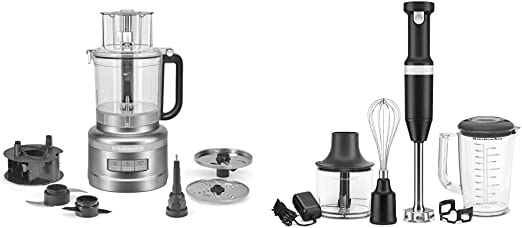


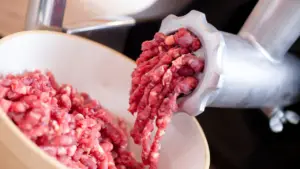


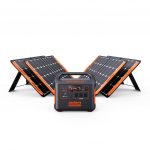

[…] share files with remote teams by creating a secure, encrypted connection between devices. This connection can protect the files being transferred from potential interception or data theft. VPNs can also […]
[…] food processor blender combo is a versatile kitchen appliance that saves time, space, and money. It allows you to perform […]
[…] control is the ability to streamline your cooking process. No more running back and forth between appliances or worrying about overcooking. With smart gadgets, you have the power to manage your cooking devices […]